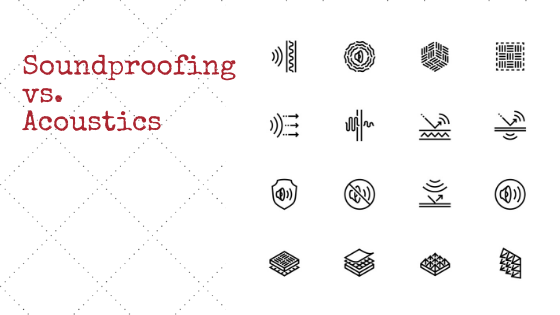
Outlining the Difference Between Soundproofing & Acoustic Treatment
Here's a short explanation:
Soundproofing is a means of reducing or eliminating the source of a sound from the receiver of that sound, such as someone's ears. It can be thought of as “isolation.” Soundproofing is used to prevent sounds from either traveling outside of a defined space or encroaching into that space from an exterior area.
What is acoustic treatment?
Acoustic treatment is a method of changing the dynamics of sound waves within a given space and is designed to give listeners a clearer or truer listening experience. Application of acoustic treatments is often done to improve sound quality in music listening rooms, recording studios, lecture halls, concert halls, classrooms, churches, hospitals, restaurants, offices or any other space where critical listening or sound quality is important. The means for achieving this are vast and include options such as
Acoustical Fabric-Wrapped Panels with both ceiling-suspended options and wall-hung applications.
Soundproofing Versus Sound Absorption
If you're experiencing noise problems, soundproofing enables you to block those noises to lessen the effect of sound waves either exiting or entering a defined listening space. If you like to play loud music, for example, but are getting complaints from neighbors who may not share your enthusiasm for high-volume hard rock or heavy metal, soundproofing can help. If you're setting up a recording studio in your spare bedroom at home and want to block out the annoying sounds of the traffic going by, soundproofing can be your answer here, too.
Soundproofing typically requires the application of
sound-insulating materials – usually heavy, dense materials – to block out sound waves that might otherwise pass through walls, windows, doors, ceilings and floors. Using sound-insulating materials to stop sound waves from entering or exiting a defined space may not totally mitigate all noise disturbances but may have a marked effect on lessening them.
Sound absorption is an effective method of lessening certain noises and echoing effects within a space and is typically achieved by using soft materials capable of soaking up sounds as they hit the surface of these materials. Products used to achieve these results may include acoustic baffles, fabric wall panels and acoustic ceiling systems, among others. Whether it's excessive noise in an office environment, a bothersome echo (natural reverberation) in a theater or music hall or unintelligibly poor speech in a classroom or lecture hall, acoustic treatment using sound-absorbing materials expertly applied can vastly improve poor sound conditions.
|
|
|

